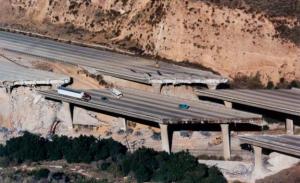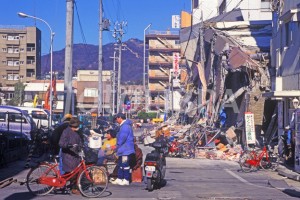 While my inner punk rocker smiles at the term, the Damage and Destruction clause in any office lease is no laughing matter. Although seldom used, it can be the most serious provision in a lease if a major destructive event (Fire, Flood, Earthquake, etc.) affects the occupancy of a building.
While my inner punk rocker smiles at the term, the Damage and Destruction clause in any office lease is no laughing matter. Although seldom used, it can be the most serious provision in a lease if a major destructive event (Fire, Flood, Earthquake, etc.) affects the occupancy of a building.
 While many tenants have never had to deal with the practical realities of such an event, some have not been so lucky. Early in my career (January 17th, 1994) a catastrophic earthquake rocked the San Fernando Valley and parts of the Westside of Los Angeles. The 1994 Northridge Earthquake had a magnitude of 6.7, but the ground acceleration was one of the highest ever recorded in a major metropolitan area in North America, and damage was widespread. The earth moved upward so quickly that many buildings, including steel “moment frame” office buildings, were damaged to the point of being “Red Tagged.” Essentially the city shut these buildings down, tenants had limited or no access to their suites, and the Damage and Destruction clause in their leases came into play.
While many tenants have never had to deal with the practical realities of such an event, some have not been so lucky. Early in my career (January 17th, 1994) a catastrophic earthquake rocked the San Fernando Valley and parts of the Westside of Los Angeles. The 1994 Northridge Earthquake had a magnitude of 6.7, but the ground acceleration was one of the highest ever recorded in a major metropolitan area in North America, and damage was widespread. The earth moved upward so quickly that many buildings, including steel “moment frame” office buildings, were damaged to the point of being “Red Tagged.” Essentially the city shut these buildings down, tenants had limited or no access to their suites, and the Damage and Destruction clause in their leases came into play.
 While Damage and Destruction language can be invoked from far less dramatic events, clear cut damage from an earthquake helps illustrate some of the big issues to look out for in your lease.
While Damage and Destruction language can be invoked from far less dramatic events, clear cut damage from an earthquake helps illustrate some of the big issues to look out for in your lease.
 1. Insurance: Does the landlord carry enough insurance to repair or rebuild the building? What does it cover? Earthquakes? Does the tenant carry enough to cover the tenant improvements? There are a lot of insurance related issues that need to be carefully dealt with in the D&D clause.
1. Insurance: Does the landlord carry enough insurance to repair or rebuild the building? What does it cover? Earthquakes? Does the tenant carry enough to cover the tenant improvements? There are a lot of insurance related issues that need to be carefully dealt with in the D&D clause.

 2. Time Frames and dates are extremely important. How much time does the landlord have to repair the building? And from what date? Generally, in a big event, the landlord needs time to assess the damage and put a plan in place to repair/replace the building (or not). 60 days is usually enough time to make those decisions and the landlord should be limited to that in the D&D clause. The date that kicks off that time frame off is often hotly contested. Is it from the time of damage, tenants notification of the damage, or landlord becoming aware of the damage? The landlord and tenant usually have a right to terminate the lease if the building cannot be repaired in a reasonable amount of time. 6 months is a long time to be waiting to get back in your space. But a year might actually be more reasonable if we are talking about a corporate headquarters sized lease. Anticipated availability in the market will also effect your strategy on time frames.
2. Time Frames and dates are extremely important. How much time does the landlord have to repair the building? And from what date? Generally, in a big event, the landlord needs time to assess the damage and put a plan in place to repair/replace the building (or not). 60 days is usually enough time to make those decisions and the landlord should be limited to that in the D&D clause. The date that kicks off that time frame off is often hotly contested. Is it from the time of damage, tenants notification of the damage, or landlord becoming aware of the damage? The landlord and tenant usually have a right to terminate the lease if the building cannot be repaired in a reasonable amount of time. 6 months is a long time to be waiting to get back in your space. But a year might actually be more reasonable if we are talking about a corporate headquarters sized lease. Anticipated availability in the market will also effect your strategy on time frames.
 3. Rent Abatement during the time a tenant cannot access it’s space is critical and most leases provide language extending such a benefit to the tenant. However, I have seen many landlords argue that the tenant should carry insurance for such an occasion. Don’t get caught in that argument. The landlord should be responsible for any rental loss due to D&D.
3. Rent Abatement during the time a tenant cannot access it’s space is critical and most leases provide language extending such a benefit to the tenant. However, I have seen many landlords argue that the tenant should carry insurance for such an occasion. Don’t get caught in that argument. The landlord should be responsible for any rental loss due to D&D.
4. Although not a “lease language” issue, when deciding on a new location it is important to focus on the quality of the building and the quality of ownership / management. Were qualified architects, engineers and contractors used to build the project? Is it in a city/state where the codes and enforcement thereof are stringently applied? Quality of construction is an often overlooked part of the building selection process, but extremely important. Is the ownership and management qualified and prepared to address the results of a catastrophic event?
Luckily, the Northridge Earthquake happened at 4:31 AM when most people were sleeping. If it had happened five hours later many more people could have been injured or even killed. Stick with higher quality and hopefully you won’t have to read the Damage and Destruction clause throughout the term of your lease. But pay attention to this clause when negotiating your lease, just in case…

